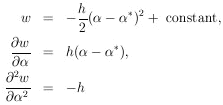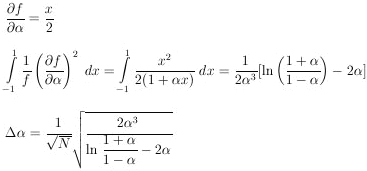


It can be shown that for large N,
 (
( ) approaches a
Gaussian distribution. To this approximation (actually the
above example is always Gaussian in
) approaches a
Gaussian distribution. To this approximation (actually the
above example is always Gaussian in
 ), we have
), we have

|
where
1 /  h is the rms spread
of
h is the rms spread
of  about
about
 *,
*,

|
Since 
 as defined in Eq. (3) is
1 /
as defined in Eq. (3) is
1 /  h , we have
h , we have

| (7) |
It is also proven in Cramer
[4] that no method of
estimation
can give an error smaller than that of Eq. 7 (or its alternate
form Eq. 8). Eq. 7 is indeed very powerful and important. It
should be at the fingertips of all physicists. Let us now
apply this formula to determine the error associated with
 * in
Eq. 6. We differentiate Eq. 5 with respect to
* in
Eq. 6. We differentiate Eq. 5 with respect to
 . The answer is
. The answer is

|
Using this in Eq. 7 gives

|
This formula is commonly known as the law of combination of
errors and refers to repeated measurements of the same quantity
which are Gaussian-distributed with "errors"
 i.
i.
In many actual problems, neither
 * nor
* nor

 may be found
analytically. In such cases the curve
may be found
analytically. In such cases the curve
 (
( ) can be
found numerically by trying several values of
) can be
found numerically by trying several values of
 and using Eq. (2) to
get the corresponding values of
and using Eq. (2) to
get the corresponding values of
 (
( ). The complete function
is then obtained by drawing a smooth curve through the points. If
). The complete function
is then obtained by drawing a smooth curve through the points. If
 (
( ) is Gaussian-like,
ð2w /
ð
) is Gaussian-like,
ð2w /
ð 2
is the same everywhere. If not, it is best to use the average
2
is the same everywhere. If not, it is best to use the average

|
A plausibility argument for using the above average goes as
follows: If the tails of
 (
( ) drop off more slowly than
Gaussian tails,
) drop off more slowly than
Gaussian tails,
 is smaller than
is smaller than

|
Thus, use of the average second derivative gives the required larger error.
Note that use of Eq. 7 for

 depends on having a particular
experimental result before the error can be determined.
However, it is often important in the design of experiments to
be able to estimate in advance how many data will be needed in
order to obtain a given accuracy. We shall now develop an
alternate formula for the maximum-likelihood error, which
depends only on knowledge of
f (
depends on having a particular
experimental result before the error can be determined.
However, it is often important in the design of experiments to
be able to estimate in advance how many data will be needed in
order to obtain a given accuracy. We shall now develop an
alternate formula for the maximum-likelihood error, which
depends only on knowledge of
f ( ; x). Under
these circumstances we wish to determine
; x). Under
these circumstances we wish to determine
 averaged over many repeated experiments
consisting of N events each. For one event we have
averaged over many repeated experiments
consisting of N events each. For one event we have

|
for N events

|
This can be put in the form of a first derivative as follows:

|
The last integral vanishes if one integrates before the differentiation because

|
Thus

|
and Eq. (7) leads to

| (8) |
Example 1
Assume in the µ-e decay distribution function,
f ( ; x) =
(1 +
; x) =
(1 +  x) / 2 ,
that
x) / 2 ,
that
 0 = - 1/3. How
many µ-e decays are needed to establish a
to a 1% accuracy (i.e.,
0 = - 1/3. How
many µ-e decays are needed to establish a
to a 1% accuracy (i.e.,
 /
/

 = 100)?
= 100)?

|
Note that

|
For

|
For this problem

|